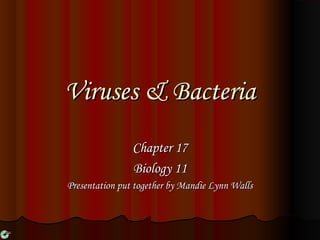More Related Content Similar to Viruses (1) (20) 2. What are Viruses
A virus is a non-cellular particle made
up of genetic material and protein
that can invade living cells.
5. EEsscchheerriicchhiiaa CCoollii BBaacctteerriiuumm
EE.. ccoollii iiss aa bbaacctteerriiuumm.. TThhaatt iiss aa ccrruuddee cceellll,, iitt iiss nnoott aa vviirruuss
bbeeccaauussee vviirruusseess aarree pprrootteeiinn ccoonnttaaiinneerrss wwiitthh DDNNAA ccoorreess oorr
RRNNAA ccoorreess..
6. EE.. CCoollii aanndd tthhee
BBaacctteerriioopphhaaggee
WWhhaatt iitt llooookkss lliikkee iinn rreeaall lliiffee
7. TThhee SSttrruuccttuurree OOff aa VViirruuss
VViirruusseess aarree
ccoommppoosseedd ooff aa ccoorree
ooff nnuucclleeiicc aacciidd
TThhee NNuucclleeiicc aacciidd ccoorree
iiss ssuurrrroouunnddeedd bbyy aa
pprrootteeiinn ccooaatt ccaalllleedd aa
ccaappssiidd
TThhee NNuucclleeiicc ccoorree iiss
eeiitthheerr mmaaddee uupp ooff
DDNNAA oorr RRNNAA bbuutt
nneevveerr bbootthh
9. VVaacccciinneess
►VViirruusseess ggrroowwnn oonn cchhiicckkeenn eemmbbrryyooss aarree
aatttteennuuaatteedd vvaacccciinneess
►AAnnootthheerr ttyyppee ooff vvaacccciinnee iiss mmaaddee bbyy hheeaatt
kkiilllliinngg tthhee vviirruuss
11. A typical, "minimal" retrovirus
consists of:
•an outer envelope which
was derived from the plasma
membrane of its host
•many copies of an envelope
protein embedded in the lipid
bilayer of its envelope
•a capsid; a protein shell
containing
•two molecules of RNA and
•molecules of the enzyme
reverse transcriptase
13. Prokaryotes
Cells that do not have a
nucleus
Exist almost every where on
earth
Grow in numbers so great you
can see them with the unaided
eye
Are placed in either the
Eubacteria or the
Archebacteria Kingdoms
Make up the smaller of the two
kingdoms
15. EEuubbaacctteerriiaa
MMaakkee uupp tthhee llaarrggeerr ooff
tthhee ttwwoo pprrookkaarryyoottee
kkiinnggddoommss
GGeenneerraallllyy aarree
ssuurrrroouunnddeedd bbyy aa cceellll
wwaallll ccoommppoosseedd ooff
ccoommpplleexx
ccaarrbboohhyyddrraatteess
16. CCyyaannoobbaacctteerriiaa
PPhhoottoossyynntthheettiicc
bbaacctteerriiuumm
BBlluuiisshh--ggrreeeenniisshh ccoolloorr
CCoonnttaaiinn mmeemmbbrraanneess
tthhaatt ccaarrrryy oouutt tthhee
pprroocceessss ooff
pphhoottoossyynntthheessiiss
DDoo nnoott ccoonnttaaiinn tthhee
ssaammee ttyyppee ooff
cchhlloorrooppllaassttss aass ppllaannttss
ddoo
TThhiiss bblluuiisshh--ggrreeeenniisshh
aallggaaee ccaann bbee ffoouunndd
nneeaarrllyy eevveerryywwhheerree oonn
eeaarrtthh..
CCaann ssuurrvviivvee iinn
eexxttrreemmeellyy hhoott
eennvviirroonnmmeennttss aanndd eevveenn
eexxttrreemmeellyy ccoolldd
eennvviirroonnmmeenntt
17. AArrcchhaaeebbaacctteerriiaa
LLaacckk iimmppoorrttaanntt
ccaarrbboohhyyddrraattee ffoouunndd
iinn cceellll wwaallllss
HHaavvee ddiiffffeerreenntt lliippiiddss
iinn tthheeiirr cceellll
mmeemmbbrraannee
DDiiffffeerreenntt ttyyppeess ooff
rriibboossoommeess
VVeerryy ddiiffffeerreenntt ggeennee
sseeqquueenncceess
AArrcchhaaeebbaacctteerriiaa ccaann
lliivvee iinn eexxttrreemmeellyy
hhaarrsshh eennvviirroonnmmeennttss
TThheeyy ddoo nnoott rreeqquuiirree
ooxxyyggeenn aanndd ccaann lliivvee
iinn eexxttrreemmeellyy ssaallttyy
eennvviirroonnmmeennttss aass wweellll
aass eexxttrreemmeellyy hhoott
eennvviirroonnmmeennttss..
19. Bacterium Shapes
Cocci~ Sphere shaped
bacteria
Bacillus~ Rod shaped bacteria
Spirrillium ~ Spiral shaped
bacteria
Flagella~ Leg-like structures
that help to propel the
bacterium.
21. CCeelllluullaarr WWaallllss
CChheemmiiccaall nnaattuurree ooff aa cceellll wwaallll ccaann bbee ddeetteerrmmiinneedd
bbyy GGrraamm SSttaaiinniinngg
BByy ffiinnddiinngg oouutt wwhhaatt ccoolloorr tthhee cceellll pprroodduucceess wwhheenn
iitt iiss ggrraamm ssttaaiinneedd yyoouu ccaann ffiigguurree oouutt tthhee ttyyppee ooff
ccaarrbboohhyyddrraatteess iinn tthhee cceellll wwaallll
22. Movement
• Flagella ~ Tail like structure
the whips around to propel the
bacterium
• Cillia ~ Miniature flagella
surround the cell that help to
“swim”
• Non motile ~ Sticky cillia like
structures that keep the
bacterium from moving
29. BBaacctteerriiaa RReessppiirraattiioonn
OObblliiggaattee AAnnaaeerroobbeess
FFaaccuullttaattiivvee
AAnnaaeerroobbeess
OObblliiggaattee AAeerroobbeess
LLiivvee wwiitthhoouutt OOxxyyggeenn
CCaann lliivvee wwiitthh oorr
wwiitthhoouutt ooxxyyggeenn
CCaannnnoott lliivvee wwiitthhoouutt
ooxxyyggeenn..
32. Conjugation
A type of Bacteria
Sex
Two organism swap
genetic information,
that contains the
information such as a
resistance to penicillin
33. SSppoorree FFoorrmmaattiioonn:: EEnnddoossppoorree
AA ttyyppee ooff ddoorrmmaanntt cceellll
EExxhhiibbiitt nnoo ssiiggnnss ooff lliiffee
HHiigghhllyy rreessiissttaanntt ttoo
eennvviirroonnmmeennttaall ssttrreesssseess ssuucchh
aass::
--HHiigghh tteemmppeerraattuurreess
--IIrrrraaddiiaattiioonn
--SSttrroonngg aacciiddss
--DDiissiinnffeeccttaannttss
EEnnddoossppoorreess aarree ffoorrmmeedd bbyy
vveeggeettaattiivvee cceellllss iinn rreessppoonnssee ttoo
eennvviirroonnmmeennttaall ssiiggnnaallss tthhaatt
iinnddiiccaattee aa lliimmiittiinngg ffaaccttoorr ffoorr
vveeggeettaattiivvee ggrroowwtthh,, ssuucchh aass
eexxhhaauussttiioonn ooff aann eesssseennttiiaall
nnuuttrriieenntt..
34. SSyymmbbiioossiiss
CClloossee rreellaattiioonnsshhiipp
bbeettwweeeenn ttoo ssppeecciieess iinn
wwhhiicchh aatt lleeaasstt oonnee
ssppeecciieess bbeenneeffiittss ffrroomm
tthhee ootthheerr
LLiivvee ttooggeetthheerr ffoorr LLIIFFEE
36. Mutualism
Symbiosis in which two
of the species live
together in such a way
that both benefit from
the relationship
Eg. E-coli
39. This powerpoint was kindly donated to
www.worldofteaching.com
http://www.worldofteaching.com is home to over a
thousand powerpoints submitted by teachers. This is a
completely free site and requires no registration. Please
visit and I hope it will help in your teaching.
